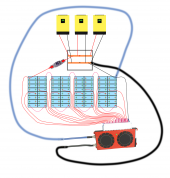Sorry, I missed that.
Reading ...
There is one little problem he does not take in account: wear and tear.
Actually this is the main reason for the EV fires !
If you parallel more cells and there is one really weak, what happens? Lets say a 100+100+60Ah (A+B+C) cells
When you discharge you have 260Ah capacity?
If you do a slooooow discharge
(like less than 0,1C = 26A): when cell C is nearly empty (-3x 60Ah) then there will be enough Vdiff for the others to charge it (those V drops because they discharge, C cell V goes up because it is being charged).
Of course because of the Vdiff there will be not the same amount pulled from A-B and C cell. But C will discharge too.
You know from Andy's test that from about 90% to a 10% SoC battery (Vdiff = 3,34 - 3,21 = 0,13V) there is max 40A transfer.
So as soon as cell C V goes into dive the Vdiff will be enough to charge it and hold it back (not to fall from the cliff).
And when A-B cells reach the V dive part there will be not able to charge cell C as much so cell C can be over discharged.
This is why you never discharge your EV below 10% ! (we hope cells SoC diff is less than 10% ... and we know they did a proper top balance)
Also what this means for cycle life? The already low capacity C will have extra wear, that causes lower Ah, that causes even more wear.
Self .... something; sorry do not know the English word for that type of procedure where if self fastens without control (overdrive) in every cycle.
And so the weak cell fast goes from bad to worst. And only has 40Ah, 30Ah ... and then one day goes nuclear (overheating and burning down the whole pack).
If you do a normal discharge
(like 0,1-0,5C = 26-130A): when cell C is nearly empty the Vdiff will be there to charge it, but that is not enough or barely enough to maintain it on that low SoC (stagnate or slow slip down). The Cell A+B have to do the 130A load and charge the low cell C in the same time.
It is more stress to that cells too (0,5C is 50A per cell and now they have 65A/cell). C gets charged, get enough to reach Cell A-B discharge V, charge stops, goes to relax V or even micro discharge a little bit, lower V, again charged, ... like a little swing in the last 1-5% of the discharge curve ... or like floating in low SoC with low V.
You know the rest.
If you do a fast discharge
(like 1C = 260Ah): like previous but the swing has bigger amplitude or floating in lower V. Because higher A means cell A-B discharge V is already lower. Lower Vdiff means lower charge A.
What happens if you discharge 3 packs: 100+100+60Ah (pack A+B+C)
There will be charging of the pack C from pack A+B, true.
But you can set in the C pack BMS to allow charge, and disable discharge until it reaches like 3V (
cell UVPR- Under Voltage Protection Release ).
And so you lower the amplitude of this swing (not float on low V but charge). Pack C will not slip under 2,5V. The wear will be much slower (but faster than for pack A and B).
Also every cell in pack C is monitored. Eventually if there is a cell that has extra weak you will notice. BMS shuts down the pack.
And now comes the really interesting part: Charging
As you can imagine, charging occurs almost parallel, based on Ah.
After charging 60Ah cell C is full, 3,65V, little A flowing into it. But still charging.
So you float an already full cell on max charging V for a long time (+40Ah is needed for cell A-B).
That alone is a very very bad thing to do to a cell.
But A-B cells in the last 5%. Vdiff minimal C does not charge them.
And now cell C V rises. Overcharge. There is no BMS to detect that, to stop the charge. BMS knows the average V of the 3 cell (cell C charging A+B).
And that is why you never (fast) charge your EV to 100%. Best not to charge over 90% (we hope SoC diff is below 10% ... and we know they did a proper top balance)
What happens if you charge 3 packs:
BMS simply stops charge on the 60Ah pack after full.
You can twist it even more if you set 3,45-3,55V/cell as full. (
cell OVPR- Over Voltage Protection Release)
You really do not need absorption, and you really want to avoid floating at max V.






